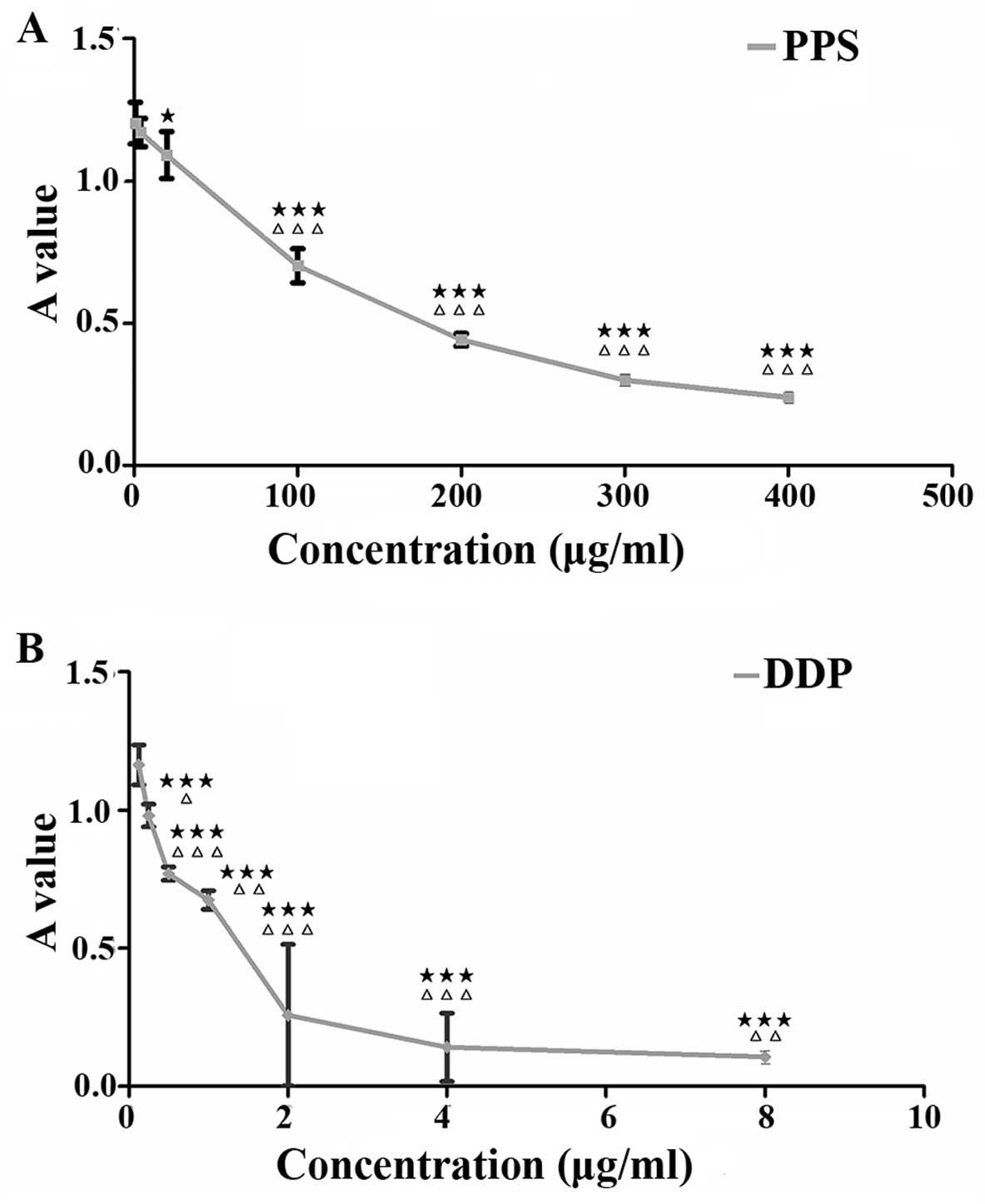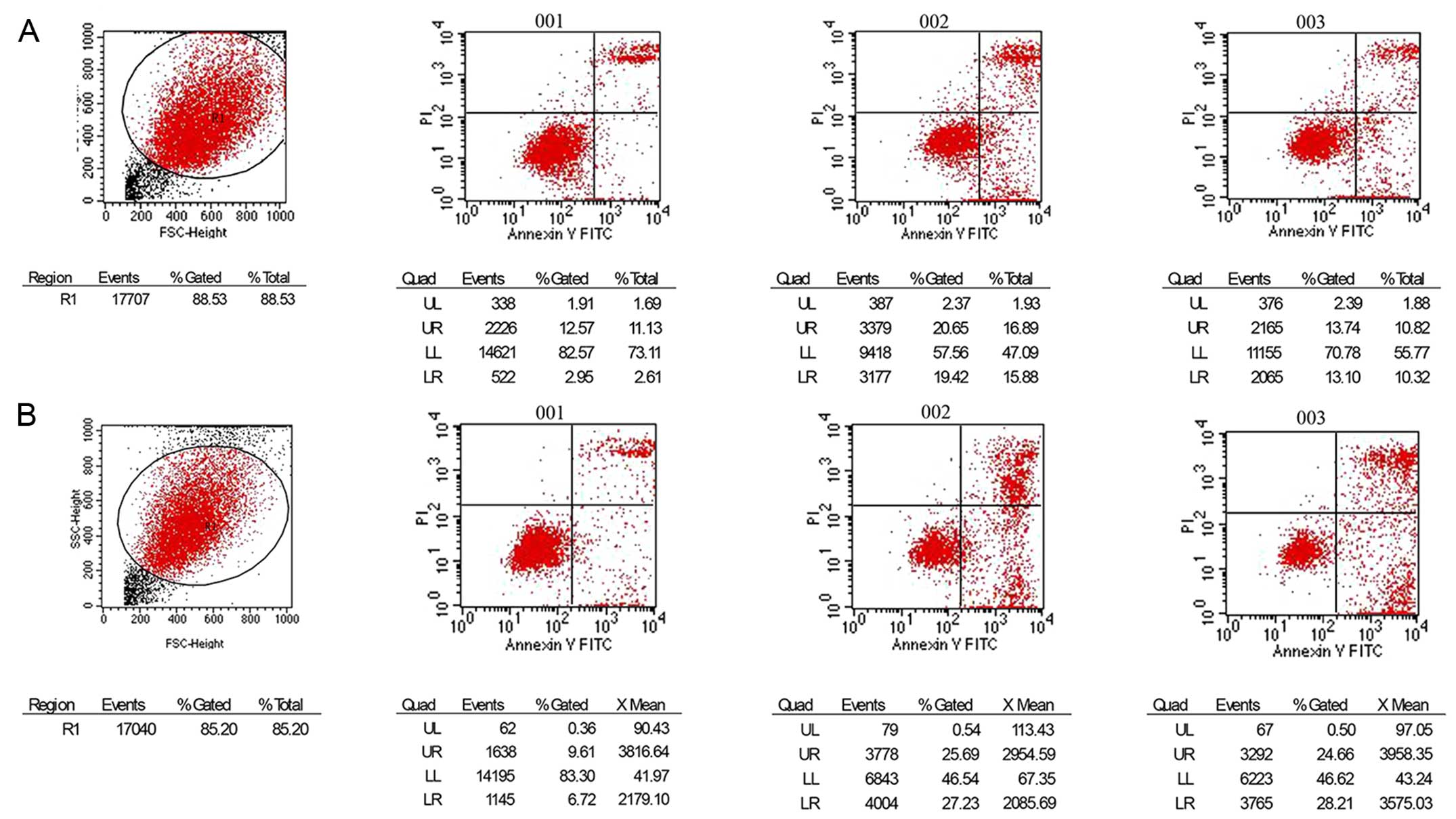|
1
|
Zhang L, Huang J, Yang N, Greshock J,
Megraw MS, Giannakakis A, Liang S, Naylor TL, Barchetti A, Ward MR,
et al: microRNAs exhibit high frequency genomic alterations in
human cancer. Proc Natl Acad Sci USA. 103:9136–9141. 2006.
View Article : Google Scholar : PubMed/NCBI
|
|
2
|
Yap TA, Carden CP and Kaye SB: Beyond
chemotherapy: Targeted therapies in ovarian cancer. Nat Rev Cancer.
9:167–181. 2009. View
Article : Google Scholar : PubMed/NCBI
|
|
3
|
Eisenhauer EL, Tew WP, Levine DA, Lichtman
SM, Brown CL, Aghajanian C, Huh J, Barakat RR and Chi DS: Response
and outcomes in elderly patients with stages IIIC-IV ovarian cancer
receiving platinum-taxane chemotherapy. Gynecol Oncol. 106:381–387.
2007. View Article : Google Scholar : PubMed/NCBI
|
|
4
|
Boren T, Xiong Y, Hakam A, Wenham R, Apte
S, Chan G, Kamath SG, Chen DT, Dressman H and Lancaster JM:
MicroRNAs and their target messenger RNAs associated with ovarian
cancer response to chemotherapy. Gynecol Oncol. 113:249–255. 2009.
View Article : Google Scholar : PubMed/NCBI
|
|
5
|
Li SD, Zhang JR, Wang YQ and Wan XP: The
role of microRNAs in ovarian cancer initiation and progression. J
Cell Mol Med. 14:2240–2249. 2010. View Article : Google Scholar : PubMed/NCBI
|
|
6
|
Li GL, Jiang W, Xia Q, Chen SH, Ge XR, Gui
SQ and Xu CJ: HPV E6 down-regulation and apoptosis induction of
human cervical cancer cells by a novel lipid-soluble extract (PE)
from Pinellia Pedatisecta Schott in vitro. J Ethnopharmacol.
132:56–64. 2010. View Article : Google Scholar : PubMed/NCBI
|
|
7
|
Sun GX, Ding SS and Qian YJ: The
extraction and chemical analysis of proteins from Pinellia
Pedatisecta and their inhibitory effects on the mouse sarcoma-180.
Acta Academiae Medicinae Shanghai. 19:17–20. 1992.
|
|
8
|
Bolger AM, Lohse M and Usadel B:
Trimmomatic: A flexible trimmer for Illumina sequence data.
Bioinformatics. 30:2114–2120. 2014. View Article : Google Scholar : PubMed/NCBI
|
|
9
|
Trapnell C, Pachter L and Salzberg SL:
TopHat: Discovering splice junctions with RNA-Seq. Bioinformatics.
25:1105–1111. 2009. View Article : Google Scholar : PubMed/NCBI
|
|
10
|
Trapnell C, Roberts A, Goff L, Pertea G,
Kim D, Kelley DR, Pimentel H, Salzberg SL, Rinn JL and Pachter L:
Differential gene and transcript expression analysis of RNA-seq
experiments with Tophat and Cufflinks. Nat Protoc. 7:562–578. 2012.
View Article : Google Scholar : PubMed/NCBI
|
|
11
|
Trapnell C, Hendrickson DG, Sauvageau M,
Goff L, Rinn JL and Pachter L: Differential analysis of gene
regulation at transcript resolution with RNA-seq. Nat Biotechnol.
31:46–53. 2013. View
Article : Google Scholar
|
|
12
|
Kanehisa M and Goto S: KEGG: Kyoto
encyclopedia of genes and genomes. Nucleic Acids Res. 28:27–30.
2000. View Article : Google Scholar
|
|
13
|
Ma X, Wehland M, Aleshcheva G, Hauslage J,
Wasser K, Hemmersbach R, Infanger M, Bauer J and Grimm D:
Interleukin-6 expression under gravitational stress due to
vibration and hypergravity in follicular thyroid cancer cells. PLOS
One. 8:e681402013. View Article : Google Scholar : PubMed/NCBI
|
|
14
|
Livak KJ and Schmittgen TD: Analysis of
relative gene expression data using real-time quantitative PCR and
the 2(-Delta Delta C(T)) method. Methods. 25:402–408. 2001.
View Article : Google Scholar
|
|
15
|
Li GL, Gui SQ and Zhu DH: Effects of
pinellia extraction only or combined with cisplatin on growth of
Hela cells of cervical cancer. Fudan Univ J Med Sci. 34:869–872.
2007.
|
|
16
|
Echevarria F, Norton RA, Nes WD and Lange
Y: Zymosterol is located in the plasma membrane of cultured human
fibroblasts. J Biol Chem. 265:8484–8489. 1990.PubMed/NCBI
|
|
17
|
Lange Y, Echevarria F and Steck TL:
Movement of zymosterol, a precursor of cholesterol, among three
membranes in human fibroblasts. J Biol Chem. 266:21439–21443.
1991.PubMed/NCBI
|
|
18
|
Brown DA and London E: Structure and
function of sphingolipid- and cholesterol-rich membrane rafts. J
Biol Chem. 275:17221–17224. 2000. View Article : Google Scholar : PubMed/NCBI
|
|
19
|
Edwards PA and Ericsson J: Sterols and
isoprenoids: Signaling molecules derived from the cholesterol
biosynthetic pathway. Annu Rev Biochem. 68:157–185. 1999.
View Article : Google Scholar
|
|
20
|
Strasser A, O'Connor L and Dixit VM:
Apoptosis signaling. Annu Rev Biochem. 69:217–245. 2000. View Article : Google Scholar : PubMed/NCBI
|
|
21
|
Jiang X and Wang X: Cytochrome C-mediated
apoptosis. Annu Rev Biochem. 73:87–106. 2004. View Article : Google Scholar : PubMed/NCBI
|
|
22
|
Ashkenazi A and Dixit VM: Death receptors:
Signaling and modulation. Science. 281:1305–1308. 1998. View Article : Google Scholar : PubMed/NCBI
|
|
23
|
Deveraux QL and Reed JC: IAP family
proteins - suppressors of apoptosis. Genes Dev. 13:239–252. 1999.
View Article : Google Scholar : PubMed/NCBI
|
|
24
|
Bratton SB, Walker G, Srinivasula SM, Sun
XM, Butterworth M, Alnemri ES and Cohen GM: Recruitment, activation
and retention of caspases-9 and -3 by Apaf-1 apoptosome and
associated XIAP complexes. EMBO J. 20:998–1009. 2001. View Article : Google Scholar : PubMed/NCBI
|
|
25
|
Boocock CA, Charnock-Jones DS, Sharkey AM,
McLaren J, Barker PJ, Wright KA, Twentyman PR and Smith SK:
Expression of vascular endothelial growth factor and its receptors
flt and KDR in ovarian carcinoma. J Natl Cancer Inst. 87:506–516.
1995. View Article : Google Scholar : PubMed/NCBI
|
|
26
|
Duyndam MC, Hilhorst MC, Schlüper HM,
Verheul HM, van Diest PJ, Kraal G, Pinedo HM and Boven E: Vascular
endothelial growth factor-165 overexpression stimulates
angiogenesis and induces cyst formation and macrophage infiltration
in human ovarian cancer xenografts. Am J Pathol. 160:537–548. 2002.
View Article : Google Scholar : PubMed/NCBI
|
|
27
|
Tischer E, Mitchell R, Hartman T, Silva M,
Gospodarowicz D, Fiddes JC and Abraham JA: The human gene for
vascular endothelial growth factor. Multiple protein forms are
encoded through alternative exon splicing. J Biol Chem.
266:11947–11954. 1991.PubMed/NCBI
|
|
28
|
Takahashi Y, Kitadai Y, Bucana CD, Cleary
KR and Ellis LM: Expression of vascular endothelial growth factor
and its receptor, KDR, correlates with vascularity, metastasis, and
proliferation of human colon cancer. Cancer Res. 55:3964–3968.
1995.PubMed/NCBI
|
|
29
|
Leng R, Zha L and Tang L: MiR-718
represses VEGF and inhibits ovarian cancer cell progression. FEBS
Lett. 588:2078–2086. 2014. View Article : Google Scholar : PubMed/NCBI
|
|
30
|
Iliopoulos O, Levy AP, Jiang C, Kaelin WG
Jr and Goldberg MA: Negative regulation of hypoxia-inducible genes
by the von Hippel-Lindau protein. Proc Natl Acad Sci USA.
93:10595–10599. 1996. View Article : Google Scholar : PubMed/NCBI
|
|
31
|
Maxwell PH, Wiesener MS, Chang GW,
Clifford SC, Vaux EC, Cockman ME, Wykoff CC, Pugh CW, Maher ER and
Ratcliffe PJ: The tumour suppressor protein VHL targets
hypoxia-inducible factors for oxygen-dependent proteolysis. Nature.
399:271–275. 1999. View
Article : Google Scholar : PubMed/NCBI
|
|
32
|
Nomura S, Yoshitomi H, Takano S, Shida T,
Kobayashi S, Ohtsuka M, Kimura F, Shimizu H, Yoshidome H, Kato A,
et al: FGF10/FGFR2 signal induces cell migration and invasion in
pancreatic cancer. Br J Cancer. 99:305–313. 2008. View Article : Google Scholar : PubMed/NCBI
|
|
33
|
Sugimoto K, Yoshida S, Mashio Y, Toyota N,
Xing Y, Xu H, Fujita Y, Huang Z, Touma M and Wu Q: Role of FGF10 on
tumorigenesis by MS-K. Genes Cells. 19:112–125. 2014. View Article : Google Scholar
|














